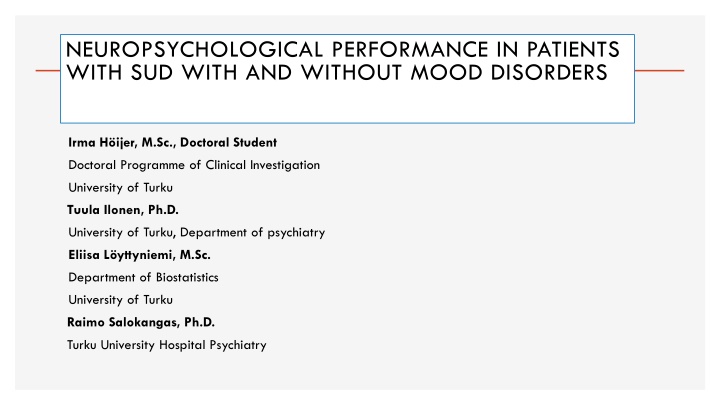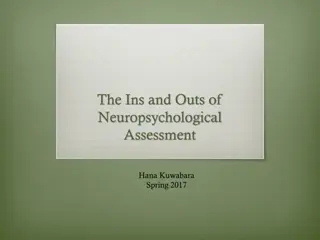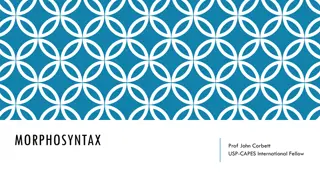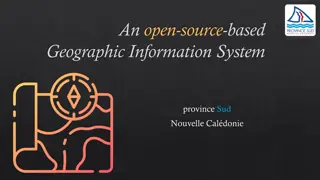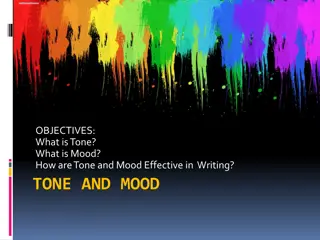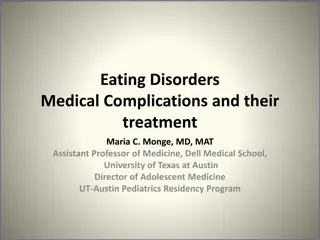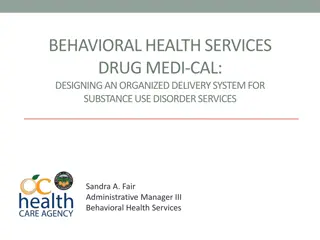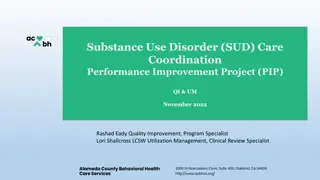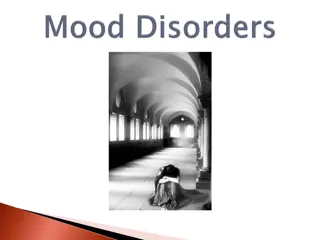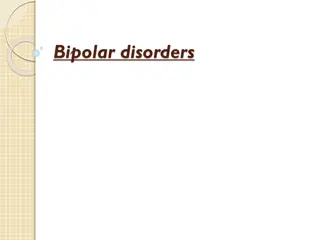Neuropsychological Performance in Patients with SUD and Mood Disorders
Substance abuse and mood disorders are associated with neuropsychological impairment. This study examines the effects of mood and substance use disorders on specific measures in hospitalized patients. Diagnoses were made according to ICD-10 criteria. Participants were categorized into SUD+MD and SUD-MD groups. The diagnostic distribution of the SUD+MD sample includes various mood disorders.
Download Presentation

Please find below an Image/Link to download the presentation.
The content on the website is provided AS IS for your information and personal use only. It may not be sold, licensed, or shared on other websites without obtaining consent from the author.If you encounter any issues during the download, it is possible that the publisher has removed the file from their server.
You are allowed to download the files provided on this website for personal or commercial use, subject to the condition that they are used lawfully. All files are the property of their respective owners.
The content on the website is provided AS IS for your information and personal use only. It may not be sold, licensed, or shared on other websites without obtaining consent from the author.
E N D
Presentation Transcript
NEUROPSYCHOLOGICAL PERFORMANCE IN PATIENTS WITH SUD WITH AND WITHOUT MOOD DISORDERS Irma H ijer, M.Sc., Doctoral Student Doctoral Programme of Clinical Investigation University of Turku Tuula Ilonen, Ph.D. University of Turku, Department of psychiatry Eliisa L yttyniemi, M.Sc. Department of Biostatistics University of Turku Raimo Salokangas, Ph.D. Turku University Hospital Psychiatry
BACKGROUND AND AIMS Substance abuse as well as mood disorder has been consistently associated with neuropsychological impairment in many cognitive domains. SUD may create a double deficit in cognitive functions in those with mood disorder and have an adverse impact on their course of illness and functional outcome. The aim of the study was to examine the effects of mood and substance use disorders on specific neuropsychological measures in a sample of single and multidrug patients with and without mood disorders.
. METHOD Participants 164 hospitalised patients, 88 with (SUD+MD) and 76 (SUD-MD) without mood disorders
PARTICIPANTS Diagnoses were made according to the criteria of ICD-10 by experienced psychiatrists. Substance use disorder (SUD) diagnoses also consisted of alcohol overuse or dependence. No significant differences were cited between SUD-MD and SUD+MD groups in the use of intoxicating substances (see table 1).
TABLE 1. SUBSTANCE USED IN PATIENTS. SUD-MD SUD+MD N=76 N=88 Only one drug 39(51%) 52(59%) Alcohol 29(38%) 39(44%) Sedatives 3(3%) 8(9%) Stimulants 3(3%) 3(3%) Opioids 3(3%) 2(1%) Multidrug 37(48%) 36(40%) Alcohol,sedatives 5(7%) 20(23%) Alcohol,cannabis 1(1%) 0(0%) Alcohol,stimulants 0(0%) 1(1%) Alcohol,otherpsychoactives 12(16%) 10(11%) Opioids,otherpsychoactives Other psychoactive substance- related disorders 9(11%) 0(0%) 10(13%) 5(5%)
DIAGNOSTIC DISTRIBUTION OF SUD+MD SAMPLE Bipolar Disorder: severe with psychotic features (F32.3; 3%), major depressive disorder, single episode, bipolar disorder (F31; 21%), Major depressive disorder, single episode, mild (F32.0; 3%), major depressive disorder, single episode, moderate (F32.1; 23%), major depressive disorder, single episode, severe without psychotic features (F32.2.;11%), major depressive disorder, single episodeunspecified (F32.9; 6%), recurrent major depressive disorder, mild (F33.0; 2%), recurrent major depressive disorder, moderate (F33.1; 6%), recurrent major depressive disorder, severe without psychotic symptoms (F33.2; 3%) recurrent major depressive disorder, in remission (F33.4; 3%), Persistent mood (affective) disorders (F34.1; 3% ) and Mixed anxiety and depressive disorder (F41.2; 13%).
SOSIODEMOGRAPHICS SUD-MD N = 76 37.8 (11.9) SUD+MD N = 88 39.1 (10.3) Statistical analysis t-test p value Age (mean, SD) Sex Male Female Level of Education No Primary School Primary School Vocational Training College-level Education Higher Education .42 ChiSquare .35 42 (43.3%) 34 (50.7%) 55 (56.7%) 33 (49.3%) ChiSquare .45 0 (0.0%) 35 (53.0%) 23 (43.4%) 10 (35.7%) 8 (47.1%) 0 (0.0%) 31 (47.0%) 32 (56.6%) 18 (64.3%) 9 (52.9%) Marital status Married Stable Partner Single Separate/Divorced ChiSquare .16 12 (48.0%) 6 (50.0 %) 36 (55.4%) 22 (35.5%) 47 (50.5%) 13 (52.0%) 6 (50.0%) 29 (44.6%) 40 (64.5%) 46 (49.5%) Unemployed Military Service (only males) Exemption Completed Unknown ChiSquare .23 ChiSquare .26 17 (53.1%) 20 (35.7%) 2 (33.3%) 15 (46.9%) 36(64.3%) 4 (66.7%) Prison ruling None Parole Prison Pending Judgment Unknown ChiSquare .29 54 (50.0%) 8 (50.0%) 10 (47.6%) 4 (100.0%) 0 (0.0%) 54 (50.0%) 8 (50.0%) 11 (52.4) 0 (0.0%) 1 (100.0%)
CLINICAL VARIABLES (1) SUD-MD N=76 SUD+MD N=88 Statistical analysis p value Onset of substance 16.2 (7.6) 16.3 (5.9) T-test 0.97 use age Onset of regular 21.2 (11.3) 23.5 (1.0) T-test 0.17 substance use Substance use 16.1 (9.4) 15.7 (8.8) T-test 0.78 duration (years) Onset of multidrug 0.01 18.6 (9.5) 24.2 (1.0) T-test use
CLINICAL VARIABLES (2) SUD-MD N=76 SUD+MD N=88 Statistical analysis p value Multidrug use in 8.2 (8.0) 10.7 (7.1) T-test 0.07 years Onset of injection 19.9 (5.3) 23.3 (6.6) T-test 0.12 drug abuse Duration of injection 4.5 (6.0) 5.7 (3.7) T-test 0.55 abuse 33.1 (12.3) 36.2 (10.3) T-test 0.09 Treatment onset age
CLINICAL VARIABLES (3) SUD-MD N=76 SUD+MD N=88 Statistical analysis p value Depression score 0.001 79.2 (17.7) 91.5 (18.4) T-test (MMPI) Affection disorder data (only males) 4.4 (4.5) Duration of disorder
TABLE 2.1 NEUROPSYCHOLOGICAL MEASURES Cognitive Domain Premorbid IQ Test Vocabulary (WAIS-R; Wechsler, 1975) Score units Standard Score Attention Digit Span Forward Digit Span Backward Total raw score, max 12 Total raw score, max 12 Speed of Processing Digit Symbol (WAIS-R; Wechsler, 1975) Simple reaction time (CogniSpeed; Revonsuo et al., 1993) Standard Score Time to complete (ms) Perceptual Reasoning Block Design (WAIS-R; Wechsler, 1975) Raven Standard Matrices (Raven, 2004) Standard Score
TABLE 2.2 NEUROPSYCHOLOGICAL MEASURES Cognitive Domain Test Score units Verbal subtests of the WMS-R (Wechsler, 1987) Immediate Logical Memory Delayed recall of Logical Memory Immediate Associate Learning Delayed recall of Associate Learning Verbal Memory Index Verbal Memory and Learning Total raw score, max 50 Total raw score, max 50 Total raw score, max 24 Total raw score, max 8 Visual subtests of (WMS-R (Wechsler, 1987) Immediate Visual Learning Delayed recall of Visual Learning Immediate Visual Reproduction Delayed recall of Visual Reproduction Visual Memory Index Visual Memory and Learning Total raw score, max 18 Total raw score, max 6 Total raw score, max 41 Total raw score, max 41 (WMS-R (Wechsler, 1987) Delayed Memory Index Delayed Memory
TABLE 2.3 NEUROPSYCHOLOGICAL MEASURES Cognitive Domain Test Score units Inhibitory Capacity CogniSpeed version of the Stroop Color-Word Test (Stroop, 1935) Neutral Condition, COL Congruous Word Condition, CON Incongruous Word Condition, IN2 Time to complete (ms), and number of errors Executive Function Total Stroop (IN2-CON) Stroop Interference (IN2-COL) CogniSpeed version of the Stroop Color-Word Test (Stroop, 1935) Time to complete (ms)
COGNISPEED COLOR REACTION TIME-TASKS Neutral Condition COL Right index finger push the reaction key red or blue as soon as possible nnnnnnnn nnnnnnnn Congruous Word Condition CON Right index finger push the reaction key red or blue as soon as possible Red Blue Incongruous Word Condition IN2 Pay attention only the color, Ignore the possible word and its meaning (semantic content) Blue Red Congruous Condition STIN nnnnnnnn nnnnnnnn Red Blue Same instructions than above Incongruous Condition STIR nnnnnnnn nnnnnnnn Red Blue Same instructions than above
RESULTS Compared with normative, memory, learning and processing speed were impaired in both SUD+MD and SUD-MD groups. Processing speed (p <0.01), perceptual reasoning (p<0.05) and susceptibility to interference (p=0.03) were more impaired in the SUD+MD group than in the SUD-MD group. The SUD+MD and SUD-MD were most powerfully separated by the Digit Symbol and Block Design tests. Cognitive interference in the SUD+MD group was significantly correlated with slowing the speed of processing.
THE DIGIT SYMBOL OF WAIS-R STANDARD SCORES FOR THE SUD-MD GROUP AND THE SUD+MD GROUP. The significant differences within each diagnostic group are shown by an asterisk (P < .01). The data shown are 95% Confidence Interval for median, Lower Bound 7.5 and Upper Bound 9.0 for the SUD-MD group; Lower Bound 6.4 and Upper Bound 7.7 for the SUD+MD group.
SIMPLE REACTION TIME OF COGNISPEED TASKS REACTION TIME (MS) FOR THE SUD-MD GROUP AND SUD+MD GROUP. The significant differences within each diagnostic group are shown by asterisk (P < .01). The Data shown are 95% Confidence Interval for median, Lower Bound 369.7 and Upper Bound 456.5 for SUD-MD Group; Lower Bound 407.2 and Upper Bound 503.2 for SUD+MD group.
THE BLOCK DESIGN TEST OF WAIS-R STANDARD SCORES FOR THE SUD-MD GROUP AND THE SUD+MD GROUP. The significant differences within each diagnostic group are shown by asterisk (P < .01). The Data shown are 95% Confidence Interval for median, Lower Bound 369.7 and Upper Bound 456.5 for SUD-MD Group; Lower Bound 407.2 and Upper Bound 503.2 for SUD+MD group.
INCONGRUOUS WORD CONDITION OF COGNISPEED TASKS REACTION TIME (MS) FOR THE SUD-MD GROUP AND THE SUD+MD GROUP. The significant differences within each diagnostic group are shown by asterisks (P < .01). The Data shown are 95% Confidence Interval for median, Lower Bound 635.0 and Upper Bound 752.3 for the SUD Group; Lower Bound 710.7 and Upper Bound836.8 for the SUD+MD group.
CONCLUSIONS SUD+MD patients may suffer from more severe cognitive deficits than SUD-MD patients. In this study processing speed was also measured by CogniSpeed tasks (simple reaction time, COL, IN2). Both groups -SUD-MD and SUD+MD - had deficits in processing speed compared to healthy controls, but mood disorders further enhanced slowing down. Mental speed was partially modulated by age in CogniSpeed tasks. Elderly patients were slower, but their higher education level was a compensatory factor diminishing the impact of ageing. The single substance used (mostly alcohol) was probably involved in test performance deterioration. The mean age of the SUD+MD patients was 38, but their processing speed was at the same level as normal 67 year olds have.
CONCLUSIONS In the SUD+MD group of this study, Stroop interference significantly slowed down information processing, both in automatic and more conscious, effortful processing. The wrong or irrelevant word slowed ink-naming performance (e.g., the blue colored letters formed the word red ) significantly independently of age, education level, multiple substance use and learning difficulties. The role of Total Stroop is less researched in mood disorders and substance abuse disorders. The Total Stroop effect is a combined effect of facilitation and interference (Revonsuo, 1995). In SUD+MD patients the increased Total Stroop was related significantly with the slowing of processing speed. It seems that patients could not use congruent and facilitative and relevant conditions (the right word red in red ink) to speed performance.
CONCLUSIONS As a quantitative measure of selective attention and executive function, Stroop tasks require future research in order to clarify what mechanisms are involved in Stroop effects in individuals with substance abuse and mood disorders. It is possible that Stroop effects are cognitive markers of comorbidity and are worthy of inclusion in future studies. The tasks may have prognostic utility among drug-dependent patients (Carpenter et al., 2006).
